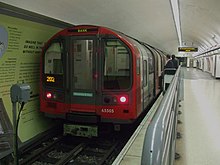Waterloo & City Line
|
|
|||||||||||||
|---|---|---|---|---|---|---|---|---|---|---|---|---|---|
|
Route of the Waterloo & City Line
| |||||||||||||
| Route length: | 2.4 km | ||||||||||||
| Line color: | turquoise | ||||||||||||
| Opening year: | 1898 | ||||||||||||
| Line type: | Tubular track | ||||||||||||
| Stations: | 2 | ||||||||||||
| Depot: | Waterloo | ||||||||||||
| Type of train used: | 1992 tube stock | ||||||||||||
| Passengers: | 15,892,000 (annually) | ||||||||||||
| Waterloo & City Line | |||||||||||||
|
|||||||||||||
The Waterloo & City Line is London Underground's shortest underground line . It was officially opened on August 8, 1898 . The line has only two stations: Waterloo and Bank ( called City until 1940 , hence the name of the line). The line is 2.4 kilometers long and crosses under the Thames , the journey time is four minutes. The main purpose of the line is to transport commuters between Waterloo Station and the financial district in the City of London . The line is closed on Sundays.
history
After the plans for this and four other lines were approved by parliament, construction of the line could begin. As the first underground line, the government-prescribed tube diameter of 3.5 meters was built. After around four years of construction, the line was opened in 1898. Trains from the American manufacturer Jackson & Sharp were initially used as rolling stock .
The route planned by engineer James Henry Greathead originally belonged to a subsidiary of the London and South Western Railway , which was incorporated into the parent company in 1907 , and from 1923 the Southern Railway . It was nationalized in 1948 along with the other railway companies . The operation took place as a supplement to the main railway lines in the Waterloo station. Originally, Waterloo station on the south side of the Thames should have been just a stopover, but in 1846 the government banned overground routes through the city center. The tariff system was fully integrated into the national railway network and it was thus possible to buy direct tickets to the bank (or earlier “City” ).
In 1994, the Waterloo & City Line was taken over by British Rail for a symbolic purchase price of one pound and transferred to the London Underground system. In January 2003, the line was closed for a little over three weeks to bring it up to date with the latest safety standards. In the same year, the Metronet consortium took over the maintenance of the route and the facilities as part of a public-private partnership program until it went bankrupt in 2008.
Due to the COVID-19 pandemic in Great Britain , the Waterloo & City Line has been out of service since March 20, 2020.
particularities
The Waterloo & City Line is colloquially known as The Drain . The reasons for this are, on the one hand, the smell of the swampy ground on which the Waterloo train station was built and, on the other hand, the tube-like shape of the tunnel. Some people think that the representation of the line on the underground network map would remind them more of a drainpipe that drains the city.
The Waterloo & City Line runs along its entire length in a single tube tunnel. This causes problems when transferring the trains to the workshop. Before the construction of the Eurostar terminal "Waterloo International" in 1990, the trains were transported individually to the surface with a special elevator on the north side of the station. Today, if necessary, the trains are lifted out of the tunnel with a mobile crane through a shaft next to the operating workshop.
Because of the break in operation on weekends, the line became a popular location for films , e.g. B. Sliding Doors (1998, with Gwyneth Paltrow in the lead role) or the TV adaptation of The Three Legged Rulers (1984).
Stations
- Bank - opened as City on August 8, 1898, renamed Bank on October 28, 1940
- Waterloo - opened on August 8, 1898
Possible stopover
- Blackfriars - the Waterloo & City Line runs under Blackfriars station . In the 1980s, proposals for the construction of an intermediate station were made there, but the Department for Transport saw no traffic advantage.
literature
- David Brownes, Oliver Green, Sam Mullins: Underground - How the tube shaped London , ISBN 978-1-846-14462-2
Web links
Individual evidence
- ^ London Underground - Performance Data . Transport for London website (Performance Data Almanac). Retrieved July 28, 2012.
- ↑ Kevin Rawlinson: London tube to close many stations because of coronavirus. The Guardian , March 19, 2020, accessed August 10, 2020 .
- ↑ http://webarchive.nationalarchives.gov.uk/+/http://www.dft.gov.uk/pgr/twa/ir/thameslinkreport/thameslink2000inspectorsrepo1034/





